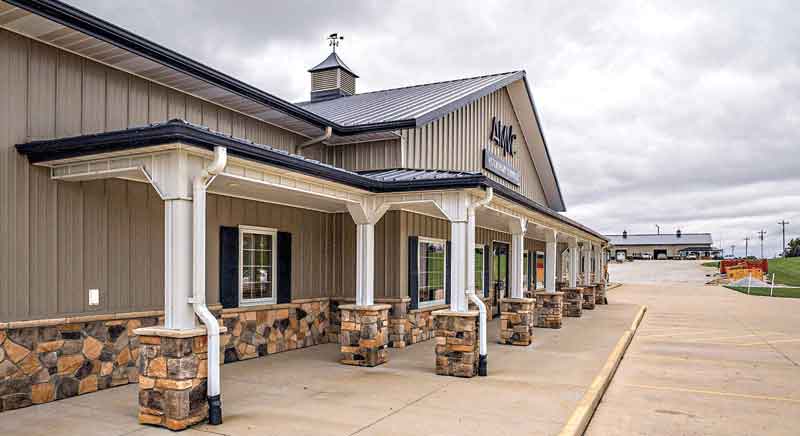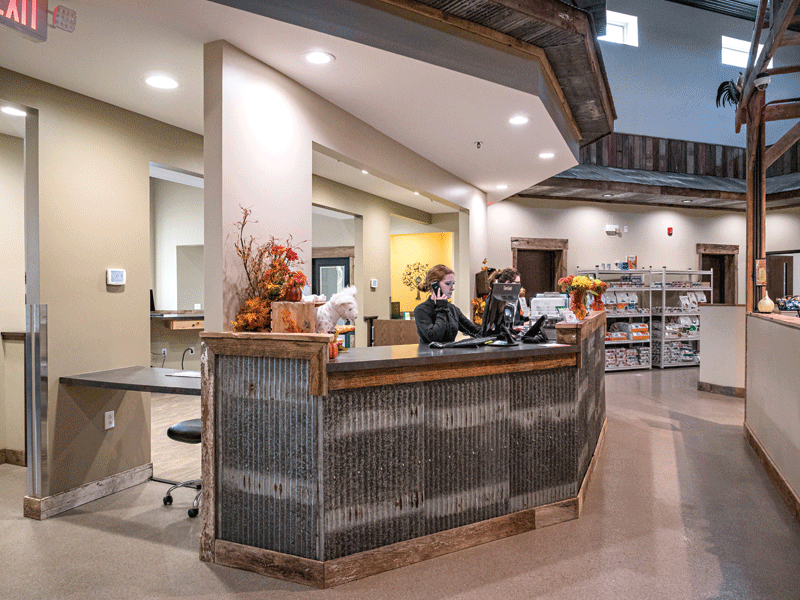
Photos courtesy Morton Buildings
Planning for a new veterinary facility may seem like an overwhelming project. The decisions to be made are numerous. With mindful consideration to some important objectives, such as budgeting, scope of the project, and planning for future growth and features, a successful outcome can be achieved.
Costs to design and build veterinary hospitals are expensive and have increased dramatically over the last three to five years. Historically, construction inflation would increase every year by an average of five to eight percent. That rate has jumped to unprecedented levels, reaching 15-60 percent higher costs year over year, depending on the scope of work, location of project, and labor environment. Finding a comfortable mix of affordability and project scope has become more challenging.
Budgeting
When developing an initial budget, it is good to know what you can afford. Working with your financial institution, accountant, architect, and design team is important. They will be able to provide high-level information in the preliminary stages of planning, and so it is recommended to initiate discussions with them as early as possible.
There are a couple of different approaches that can be used when developing a preliminary budget. First is designing a project within a specific cost range. Here, the size of the space is considered for achieving functional design and meeting your long-term business plan.
A second method is to gather all of those needs and wish list. This will help form the best vision of every goal you want to accomplish in your practice, both for the business and for your patients. Finding a balance of affordability and goal achievement sometimes requires a blend of both methods.
Building program
One way to begin the spatial and size planning of the facility within a preliminary budget is to engage with an architect and design team in developing a building program.
A building program is the culmination of project needs assessments, wish list spaces, and requirements that define the facility’s rooms and sizes.
A design team will know what questions to ask to gather the information through a needs assessment discussion. Many times, veterinarians may not have thought about a specific space or ways to improve functionality. The veterinarian’s input is critical to the creation of the initial program document.
This document can be created with a spreadsheet that contains a detailed list and square footage of the rooms in the facility. Total square footage of the project is calculated after a circulation factor is applied for hallways, corridors, and wall thicknesses. A veterinary hospital will need more space for circulation and wall thicknesses than typical of other building uses. The number of rooms and spatial relationships, as well as the need for proper traffic flow of staff, doctors, and patients, are the driving forces for a higher-than-normal circulation factor.
Once total square footage of the facility is developed, a preliminary budget range can be established. If the preliminary budget is unattainable, it is time to revisit the room-by-room program.
It is critical to ensure functionality is not removed to reduce the budget. When looking at reductions or cuts, consider the needs versus the wants. It is far more important to exclude the wants, as the needs are most critical to good hospital design and function. The programming tool, at this point, can be utilized to make desired changes in a thoughtful attempt to reduce the budget.

Future growth and services
A veterinarian and business owner should always be thinking about the future and potential growth opportunities. Maybe the first program for the needs assessment and wish list did not work for the budget. Just because you may be in a slightly different position with your budget than you had hoped for does not mean you should abandon your goals.
Use the programming tool to plan for future expansion by separating those spaces that were initially changed or removed into their own program.
This is also a suitable time to consider future services or offerings when the time presents itself. Perhaps boarding, day care, training, and grooming were in your business plan for service offerings in the new facility, but those spaces needed to be eliminated due to budget constraints. Plan for them to be included in a future expansion by defining a budget now, with considerations for inflation as time passes. This can be used as a target or a goal for financial planning as your first phase of the new facility increases its revenues.
It is extremely important to consider spatial relationships to a greater extent when planning for a future expansion. The first phase of the new hospital needs to be planned to accept an addition to the initial building that will be constructed.
Other factors to consider include site constraints and location of the first structure, as well as the second structure. Planning for the two structures to flow together in conjunction with minimal demolition and reconstruction will save you time and money in the long term. If the first structure can be designed to avoid any type of shutdown or closure during construction of an addition, this is a huge benefit.
Design features
Building features are significant considerations to discuss with your architect. Some veterinarians know exactly what features are needed to achieve their dream, while others are not as sure and will need their design team to offer suggestions.
A welcoming exterior presents a good impression. One that is well-maintained and has curb appeal will give clients the feeling the interior is just as well kept and clean.
The site and location may help accentuate the hospital exterior. Using landscaping that adds attention to specific areas, such as the front entry or main focal points of the structure, can be pleasing. Using attractive materials for finishes in the reception and waiting spaces can create an inviting appearance and atmosphere for the entire facility.
Introducing some natural, exterior materials into the client-facing interior spaces can produce a peaceful feeling. Using stone, reclaimed wood, old bricks, and timbers, as well as corrugated, rusty tin, may add character to your practice.
Feature walls, wainscots, furnishings, and reception desks are examples of opportunities for interesting, attractive concepts. Sometimes, a simple concept of a residential living space, with sofa seating, a fireplace and a small kitchenette can create a comfortable ambience for both clients and pets.
Functionality and efficiency
Spaces within the vet practice should allow for ease of access, ergonomics, and most importantly, safety for staff and patients. Understanding process flows of procedures and how spaces relate to one another affects efficiency. Minimizing travel times from one related space to another, thoughtful planning of equipment locations and allowing ample space for movement are important.
Arranging spaces to improve staff communication can not only increase efficiency and teamwork, but also safety for the animals needing extra attention or undergoing medical procedures.
Noise mitigation
Controlling loud noises that spread throughout the hospital is important for the well-being of staff and reduces stress for patients.
Ward locations need to be carefully programmed. Controlling noise from spreading into waiting spaces and exam rooms is extremely critical. Hospital staff will appreciate the efforts to mitigate noise in their new workplace. Clients are also looking for a quiet, calm experience with their pet when visiting the hospital. Loud noises, such as barking, can upset pets upon entering the hospital, making for a stressful experience before anything has been done procedurally.
Properly constructed separation partitions, utilizing sound-reducing materials in the walls and ceilings, and placing doors in correct locations are great ways to reduce sound transmission.
Cleaning and sanitation
It is imperative that cleaning and sanitation are included in the building design for controlling odors, removing wastes, and eliminating the spread of disease. Finished materials and surfaces should be durable and easy
to clean.
Isolation spaces should be designed so patients with contagious diseases can be safely and efficiently brought directly in them without exposure to the “clean” areas.
Proper design of the HVAC systems should prevent any contaminated or dirty air returning to the supply air and spreading to “clean” spaces. Wet-dry vacuum systems are great tools to allow staff to dispense pre-mixed disinfectant solutions with water to sanitize the flooring. Any dry materials, such as hair or food spills, can also be removed through the central vacuum unit.
Installing drainage systems within targeted locations in the facility is another way to maintain cleanliness. Trench drains located in dog wards and isolation rooms serve as key components for removal of waste after solids are collected and disposed. Flush systems might also be incorporated into trench drains to ensure improved cleanliness and removal of contaminants.
Implementing a team of professionals and sharing ideas for creating a veterinary hospital are critical to a project’s success. Budgets and desired project scopes can be challenging to manage, but with forward thinking, thoughtful decisions based on your business and vision, they can be achieved.
Attractive, clean, safe, and well-planned projects can lead to future growth, increased revenues, a better working environment, and most importantly, satisfied clients and pet patients.
Scott Webster is a project manager for Morton Buildings, Inc., and has been with the company for 27 years. Webster’s primary focus has been in the design, budgeting, and project development of veterinary hospitals, boarding kennels, daycare, training facilities, and other animal service ventures.
